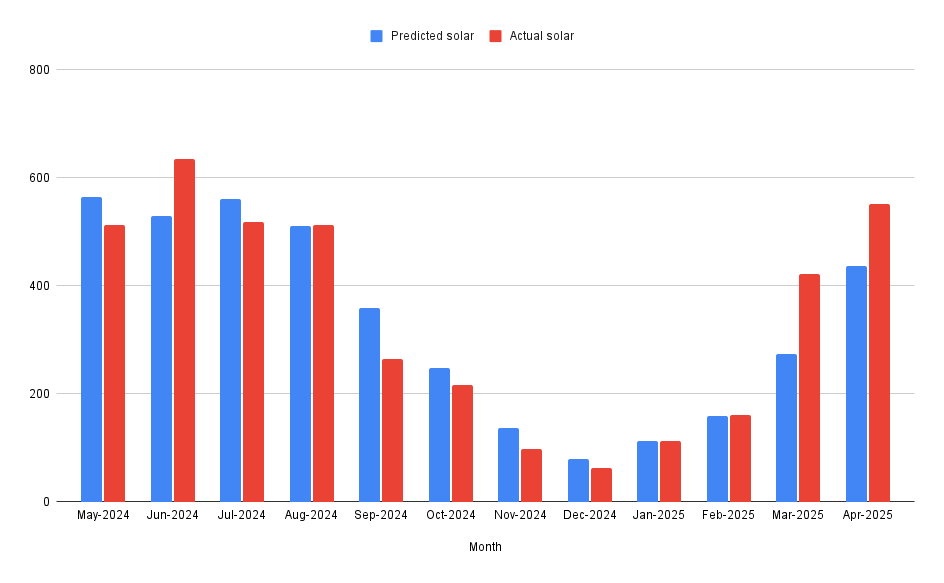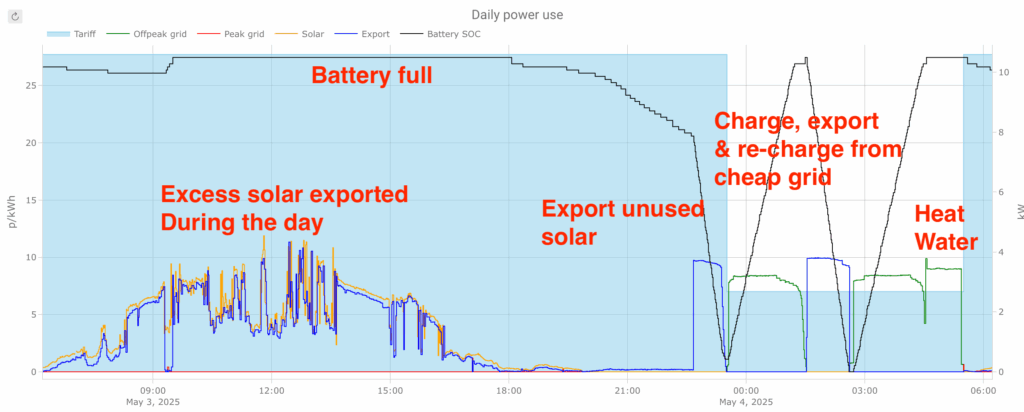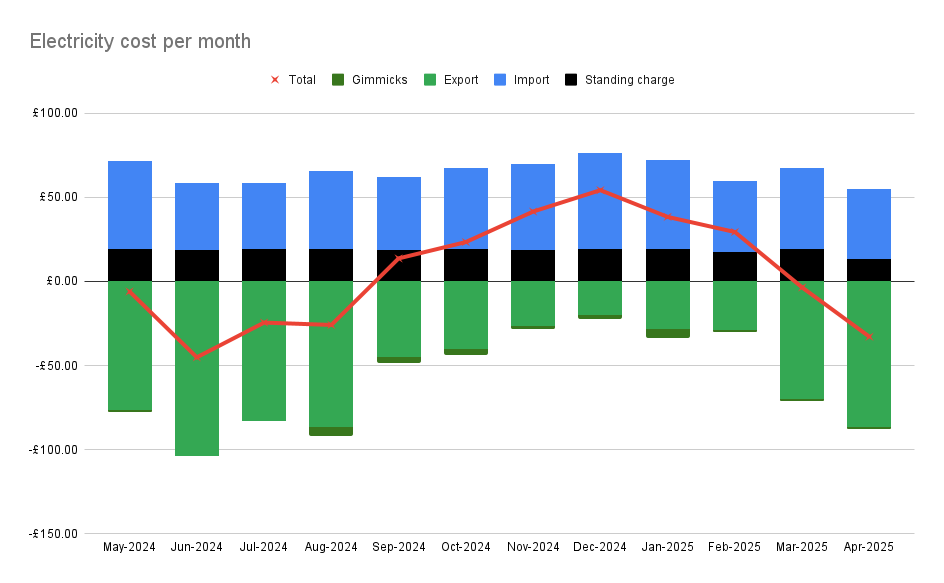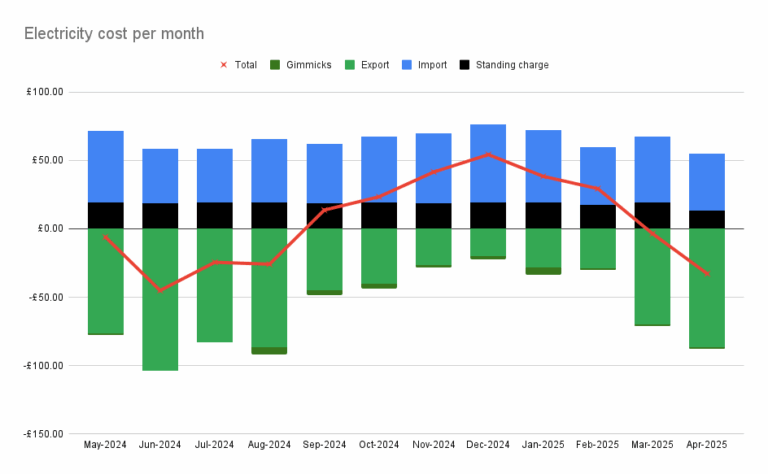A year or so ago I presented How to reduce your electricity bill to zero talk (initially over on u3acommunities.org computing group) – it’s now been running for a year, so time to check progress.
General approach
After getting my solar + house battery installed, I’ve tried to reduce my electricity (£ and carbon footprint) as much as possible by :
- Choosing a good tariff plan from energy supplier
- Charge house battery when electricity is cheap
- Use house battery to power house when electricity is expensive
- Use solar to top-up house battery and sell excess back to the grid
- Heat hot water tank when electricity is cheap
- Use any special deals from energy supplier
- Automate with Home Assistant
My specific
This is what I have :
- Octopus intelligent go tariff for electricity import – so overnight I’m charged 7p/kWh. I also get the 7p/kWh when I plug my car in (at which point the whole house gets the rate). Octopus determines when exactly my car is charged based on my requirements. The daytime rate is currently 27.7p/kWh but thats less important since I rarely use it.
- Octopus outgoing tariff for electricity export – this pays be 15p/kWh for anything I can export back to the grid
- myenergi zappi, for car charging, and a myenergi libbi for house storage (with just a 5.1kWh battery)
- 4.5kW peak solar facing south-east (so catches the morning sun)
- Given the above, my main home automation rules via home assistant rules are :
- Charge battery when electricity is cheap (overnight + car charging)
- Heat hot water via immersion heater so that it’s up to temperature as the cheap rate finishes
- If the battery has any charge left at the end of the day, export to grid just before cheap rate starts
- During cheap rate, once battery is charged, export & re-charge
- Join octopus saving sessions (if its worth it)
- During cheap rates enable some ancillary devices (like tool battery charging, pond pump)
- Make use of free electricity when available
- Use a calendar to disable some automations when away
1 year results
Solar was pretty good this year. Expected was 3.97MWh actual 4.06MWh.

So this is what a typical day looks like :

Over 12 months, winter time costs but summer earns :

So over this period, the totals are :
- 4,060kWh of solar
- 7,048kWh imported, costing £563.43 + £220.17 standing charge = £783.60
- 4,638kWh exported, earning £694.87
- £26.69 of saving sessions and other “gimmics”
- Giving a total cost of £62.04 / year, or £5.17 / month – so not quite zero as the talk predicted
- Since house consumption was 6,469kWh over the year, with no solar/battery/smart tariffs that would have cost about £1,790.80/year
- Estimated savings of £1,728.76 / year, or a return on investment in 4.9 years
- Estimated CO2 savings 888kg/year (carbon negative in june/july/august)
This is for all household electricity use, which includes hot water and car charging. Excluded is car charging away from home. Currently, gas is used only during the winter months for heating.
Problems, risks & concerns
Over the last 12 months, there have been some issues :
- Some automations failed – some due to me, others due to loosing connectivity with the myenergi servers. Means I saved slightly less than I could have done.
- I’ve had some issues with the libbi battery – eg trip switches flipping and CT failing. Again, means I saved slightly less than I could have done whilst those issues were fixed.
- Octopus “saving sessions” went national with much less rewards than the previous year. Mostly this meant participating in had a risk of loosing money, so most were skipped
Also, there are some concerns about this approach :
- Tariffs can change … export and intelligent octopus go are now variable rates, which mean they could change at any time
- Although the libbi battery warranty is 10 years with unlimited cycles, there is some concern that additional charge/discharge cycles could wear out the battery quicker
- Changes in home assistant, home assistant plugins and octopus/myenergi API’s
- Myenergi products are only controllable via the myenergi servers (no local API available), so should connection be lost, automations will fail
Next steps
- Continue to monitor – seek out best tariffs and tweak automations
- Consider alternatives to gas central heating – as well as further reducing carbon footprint, this would eliminate gas standing charge
- air-to-water heat pump
- electric boiler
- air-to-air heat pump
- Consider more solar
- Adding some additional panels facing south west on our garage roof would be a benefit since it would catch the evening sun. Eg 2 panels would generate about 670kWh, or £100.50 (ROI about 8 years)
- Consider more battery capacity
- More battery capacity would reduce peak grid usage when the existing batter is depleted (mostly in the winter). However, the yearly cost of peak grid was only £90.78 so it doesn’t really seem worth it.


Hello Peter I think that this is a powerful set of figures. You may have understated the position because it looks like your electricity includes your car’s use. Admittedly you would not have got the 7p rate without it. It shows the advantage of an integrated approach.
Peter
Yes, I did wonder if I should add on to the savings the estimated petrol costs !
Hi Peter, interesting blog.
I am attempting something similar to you but I also have a heat pump for space and water heating. I have only had my solar and battery setup for a couple of months and the heat pump for 9 months.
I did set up home assistant a on a raspberry pi a couple of years ago but never got into it. I am planning to use the automation features in my sigenergy inverter/battery control and vaillant heat pump apps.
I am just moving from OVO to Eon for my electricity supply, I got rid of the gas meter 2 months ago.
I’m hopeful that I can get close to a zero energy bill over a full year.